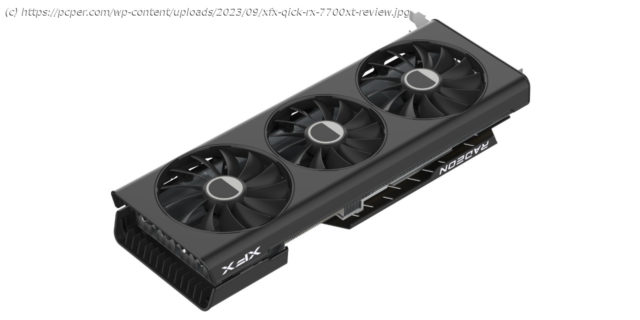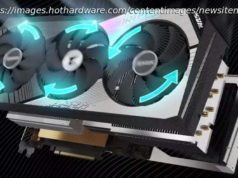XFX Speedster QICK 319 AMD Radeon RX 7700 XT Black Edition Review It has been a while since we last saw our friends from XFX. Some time back I did a review of
Introduction
It has been a while since we last saw our friends from XFX. Some time back I did a review of the XFX Speedster MERC 319 AMD Radeon RX 6800 XT BLACK (YouTube link), and I came away quite impressed. It was one of the largest cards (at the time) that I had ever worked with. It was quiet, ran cool considering the GPU and power draw, and it was quite visually striking. Perhaps most importantly it has been in constant use in the primary test machine at home for these past 3 years without a single issue. It really was an outstanding card and it withstood the test of time. Not only that it survived, but that the RX 6800 XT continued to be a high performing and relevant GPU in the intervening years.
I was given the opportunity to test out one of the latest models from XFX with the release of the RX 7700 XT series of parts. I of course welcomed it with open arms (GPU reviews are hard to come by these days). On September 6 AMD released the last two members of the Radeon RX 7000 series with the 7700 XT and 7800 XT. The 7800 XT is aimed at the higher end of the midrange market, replacing the 6800 and 6900 series of chips. The 7700 XT is designed to be an upgrade to the 6700 XT as well as directly competing with the NVIDIA RTX 4060 and RTX 4060 Ti.
The RX 7700 XT is comprised of chiplets like its bigger siblings, the 7900 series. It may share the memory chiplets with those cards, but the core GPU portion is unique to itself. It is the Navi 32 chip and is approximately 346 mm sq (4 MCD chips and 1 GCD). This gives it in theory a 256 bit memory bus (4 x 64 bit from MCDs), but since it is the 7700 XT it is cut down to 192 bits. The full 7800 XT features 16 GB of memory on the 256 bit bus, but the 7700 XT is taken down to 12 GB on a 192 bit bus. The GCD also has compute units fused off so it does not feature the full 60 that the 7800 XT does. It is down to a still reasonable 54 compute units that total up to 3456 stream processors. Rounding out the chip are 96 ROPS, 216 TMUs, and 54 Ray Accelerators.
Caches are interesting with this design as it does utilize the “Infinity Cache” setup that the 7900 series utilizes. L0 and L1 cache are on the GCD, while the L2/Infinity Cache are split between the GCD and the MCD chips. On the GCD there is 2 MB of L2 local and 48 MB of Infinity on the MCDs (3 x 16 MB per MCD- on the 7700 XT one of the MCDs is disabled). The GDDR6 is running at 18 Gbps, which gives 432 GB/sec of throughput. The combination of large caches and a fast memory bus provides a lot of effective bandwidth for the solution.
The vanilla 7700 XT features a base clock of 1900 MHz, a Game Clock of 2171 MHz, and a boost clock of 2544 MHz. These are around what users should expect from the stock, non-overclocked products that are looking to hit that $449 price point. In overbuilt cards like the XFX QICK 319, we can expect game and boost clocks to hit higher numbers consistently.
The Navi 3x series from AMD also encompass quite a few cutting edge features that are not necessarily shared with the NVIDIA RTX 4000 series. The 319 features four outputs, three of which are DP 2.1 and the other is a HDMI 2.1 unit. AMD has embraced the latest port specs for this series of cards, NVIDIA on the other hand does support HDMI 2.1 but the DisplayPorts are still 1.4a. This is not a deal killer with most displays, but it does give AMD a slight edge with concern to checkboxes. AMD also has hardware encode for the latest video formats, including AV1 and H265/HEVC.
The overall specs of the RX 7700 XT make it an able competitor in that price range. It should in theory be competitive with the last generation RX 6800, but not nearly as quick as the 6800 XT, 6900 XT, and 6950 XT. The primary target is of course the RTX 4060 Ti 8 GB and 16 GB units. For a bit more money than the 8 GB 4060 Ti a user will get better performance and 12 GB of memory. For $50 less the user will still get more performance, but will not have the extra 4 GB of memory that the RTX 4060 Ti 16GGB has. I feel that it is a reasonable tradeoff, especially in terms of overall performance. It is a bit more power hungry than the NVIDIA parts as it sits at a 245 watt TDP instead of the 165W TDP of the 16 GB 4060 Ti.The XFX Card
Now that we have discussed the technology basis for the aptly named XFX Speedster QICK 319 RX 7700 XT Black Edition, we should take a look at the card itself.
The 319 denotes the number and size of fans on the card. It features 2 x 100 mm fans and a single, centrally located 90 mm fan. 3 fans, 100 mm, and 90 mm. 319. QICK is the lower level of enthusiast cards from XFX, with MERC being the top end. Black Edition simply notes that it is an overclocked version of the RX 7700 XT.
This is an extremely long card, but it is not overly heavy. The older MERC 319 6800 XT that I reviewed last year featured a large metal shroud covering an extensive heatsink with heatpipes snaking throughout.






